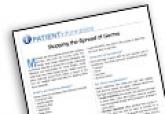Pneumocystis jiroveci pneumonia is associated with high mortality rates in immunocompromised patients who are HIV-negative. In-hospital mortality rates range from 50% to 86%. Although trimethoprim-sulfamethoxazole (TMP-SMX) is an effective prophylaxis, the wide spectrum of immunosuppressive conditions predisposing to pneumocystosis and the limited data available on its incidence in non–HIV-infected patients has made it hard to establish an evidence-based guideline, say researchers from Hôpital Pontchaillou, Hôpital Sud, and Université Rennes 1, all in Rennes, France. The study is the first to offer comparative estimates of pneumocystosis incidence rates across this patient population and helps narrow down the patients at greatest risk.
The researchers retrospectively analyzed all cases of documented pneumocystosis in HIV-negative patients admitted to Rennes University Hospital between 1990 and 2010. Of 293 cases of pneumocystosis, 154 (52.6%) tested negative for HIV.
Related: NSAIDs Linked to Poor Pneumonia Outcomes
One of the study’s main findings was that pneumocystosis remains a significant problem in both HIV-positive and HIV-negative immunocompromised patients. Second, the researchers found pneumocystosis is more severe in HIV-negative patients compared with HIV-positive patients, with much higher rates of intensive care unit (ICU) admission and in-ICU mortality.
The risk of pneumocystosis was particularly high (> 45 cases per 100,000 patient-years) in 2 groups: patients with inflammatory diseases/vasculitis (polyarteritis nodosa, granulomatosis with polyangiitis, polymyositis/dermatopolymyositis) and 3 hematologic malignancies (acute leukemia, chronic lymphocytic leukemia, and non-Hodgkin lymphoma).
Related: Linezolid Contributes to "Clinical Success" in MRSA Pneumonia
They found intermediate risk (25-45 cases per 100,000 patient-years) for Waldenström macroglobulinemia, multiple myeloma, and central nervous system cancer. For those patients, the researchers recommend a low threshold for prophylaxis; that is, any additional risk factor, such as prolonged use of corticosteroids, should prompt initiation of TMP-SMX. Most patients with solid tumors and inflammatory diseases were at low risk (< 25 cases per 100,000 patient-years).
Their study findings can help guide more systematic use of TMP-SMX prophylaxis, the researchers say. For high-risk patients, they suggest TMP-SMX prophylaxis may be beneficial, especially given the high morbidity and mortality rates. For intermediate-risk patients, the researchers recommend a low threshold for prophylaxis; that is, any additional risk factor, such as prolonged use of corticosteroids, should prompt initiation of TMP-SMX. But for low-risk patients, they advise avoiding routine pneumocystosis prophylaxis.
Source
Fillatre P, Decaux O, Jouneau S, et al. Am J Med. 2014;127(12):1242.e11-1242.e17.
doi: 10.1016/j.amjmed.2014.07.010.

